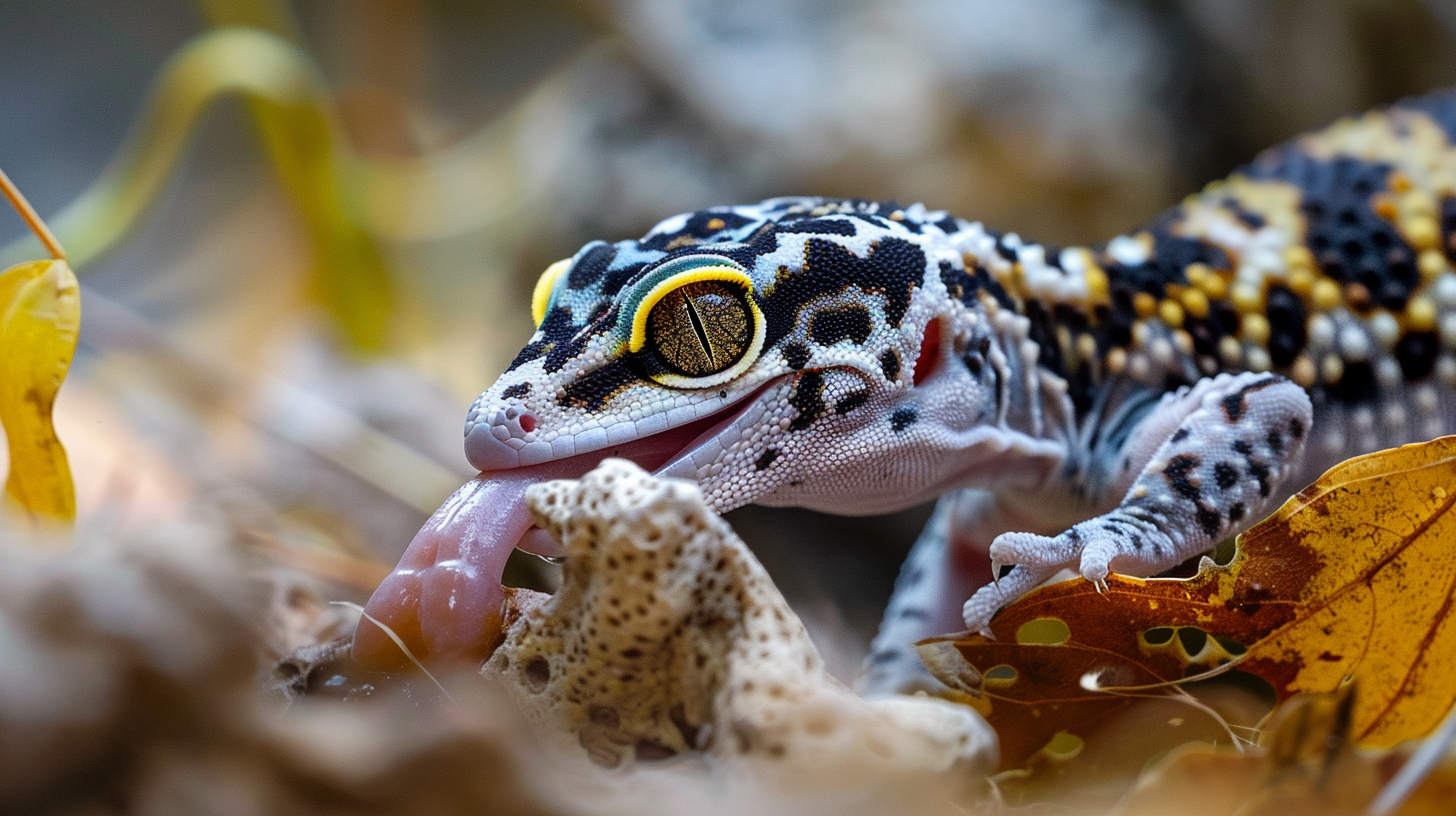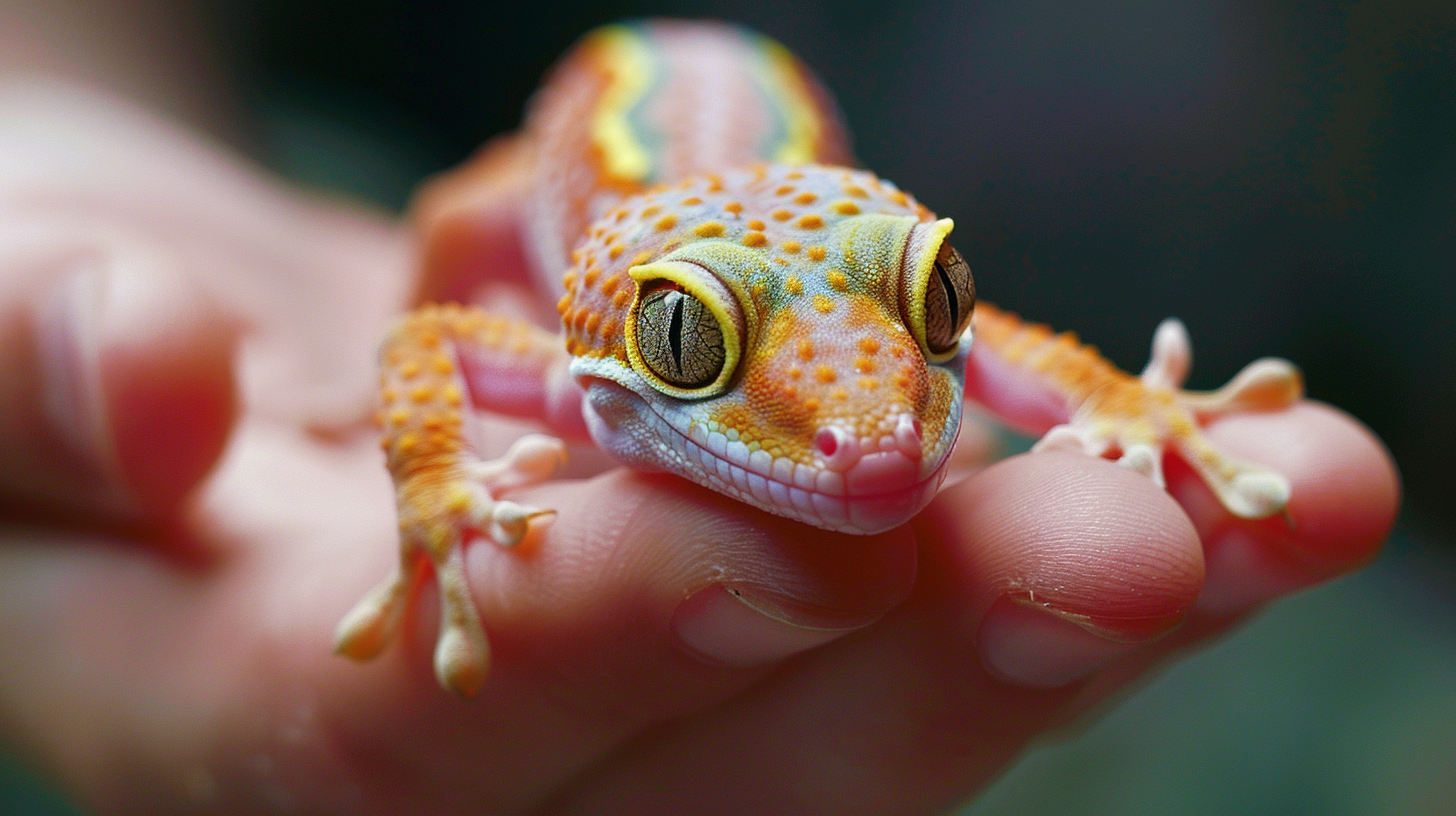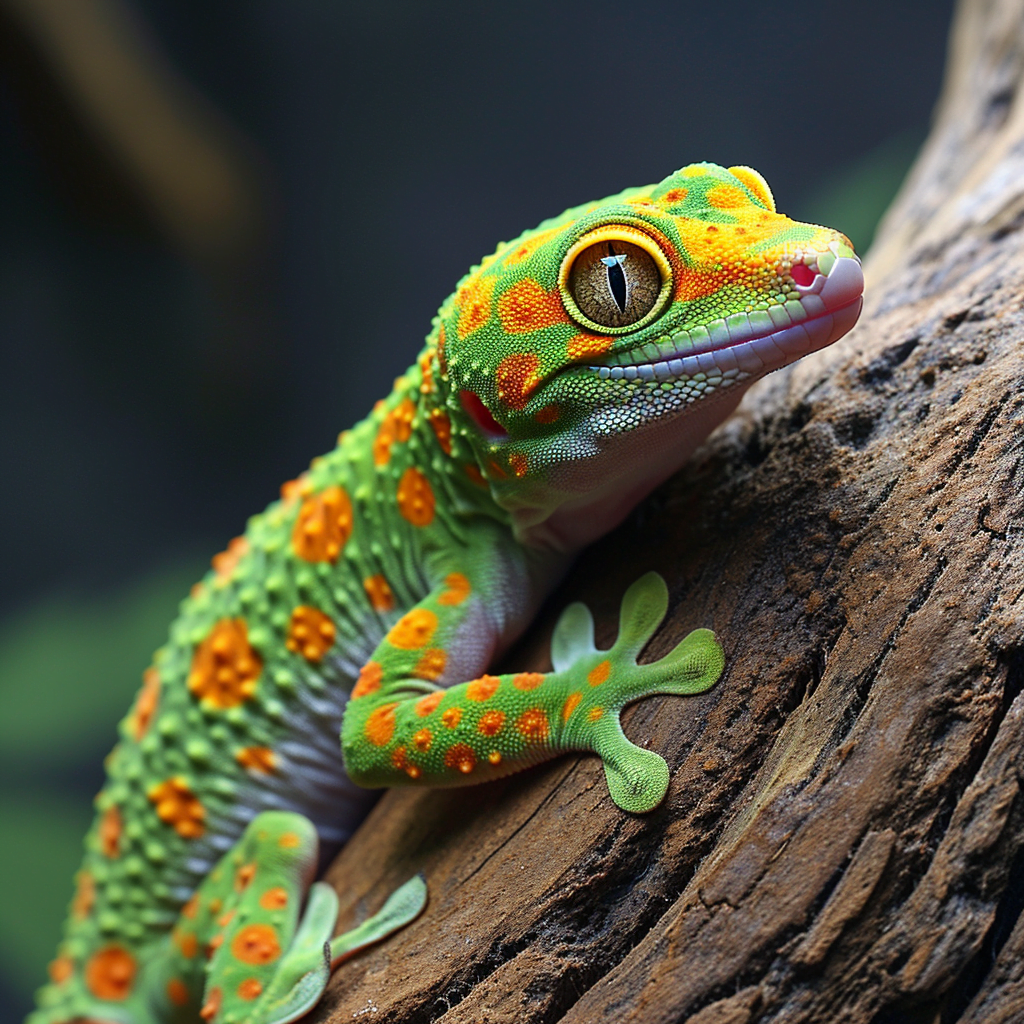Gecko Feeding Basics
Understanding the fundamentals of feeding geckos as pets is essential for ensuring their health and well-being. This section covers the frequency and quantity of food, as well as the importance of dietary supplements.
Frequency and Quantity
Feeding frequency and quantity vary depending on the age and species of the gecko. For adult leopard geckos, feeding them twice a week is generally recommended. They should be offered as many medium crickets as they can eat in one feeding, which typically ranges from 7 to 10 crickets. Small mealworms can be substituted for one of the feedings every two weeks.
Baby leopard geckos, on the other hand, tend to eat more frequently, often every day during their first year. Crested geckos should be offered food at least five times per week, with a mix of Pangea Fruit Mix Complete Gecko Diets and live insects.
| Gecko Type | Feeding Frequency | Quantity |
|---|---|---|
| Adult Leopard Gecko | Twice a week | 7-10 medium crickets |
| Baby Leopard Gecko | Daily (first year) | Varies |
| Crested Gecko | 5 times per week | Varies |
It’s important to monitor geckos for signs of overfeeding or underfeeding. Overfeeding can lead to health issues like fatty liver disease, while underfeeding can cause malnutrition and lethargy.
Supplementing the Diet
In addition to their regular diet, geckos require dietary supplements to stay healthy. Leopard geckos, for instance, need both calcium powder and vitamin/mineral powder supplements. Dusting crickets with a vitamin/calcium supplement should be done once a month.
Crested geckos also benefit from a varied diet that includes both prepared gecko diets and live insects. The Pangea Fruit Mix Complete Gecko Diets can be fed 3-4 days a week, while live insects should be offered 1-2 days a week to provide necessary exercise and mental stimulation.
| Supplement | Gecko Type | Frequency |
|---|---|---|
| Calcium Powder | Leopard Gecko | Monthly |
| Vitamin/Mineral Powder | Leopard Gecko | Monthly |
| Pangea Fruit Mix | Crested Gecko | 3-4 times per week |
| Live Insects | Crested Gecko | 1-2 times per week |
Proper supplementation ensures that geckos receive all the necessary nutrients to thrive. For more insights on gecko care, including habitat setup and handling, visit our articles on gecko pet care and gecko habitat setup.
Feeding Adult Leopard Geckos
Feeding adult leopard geckos requires a well-structured routine to ensure they receive the proper nutrition for their health and well-being. This section will cover the feeding schedule, types of feeders, and essential supplements.
Feeding Schedule
Adult leopard geckos should be fed twice a week. During each feeding, they can consume about 7-10 medium crickets. This routine helps maintain their ideal weight and prevents overfeeding, which can lead to health issues like fatty liver disease.
| Feeding Schedule | Quantity |
|---|---|
| Twice a week | 7-10 medium crickets |
Small mealworms can be substituted for one of the feedings once every two weeks. To avoid harming the gecko, large mealworms should have their heads smashed before feeding. Pinky mice can be given as a treat once every other month, replacing a week’s worth of crickets.
Types of Feeders
Leopard geckos thrive on a varied diet of different feeders. The primary feeders include:
- Crickets: High in protein and easy to digest, they should be the mainstay of the diet.
- Mealworms: Can be given as a part of their diet, but large ones should be prepared properly.
- Pinky Mice: An occasional treat, providing extra nutrients and variety.
| Type | Frequency | Notes |
|---|---|---|
| Crickets | Twice a week | 7-10 medium crickets |
| Small Mealworms | Once every two weeks | Can replace one feeding |
| Large Mealworms | Occasionally | Heads smashed |
| Pinky Mice | Once every other month | Treat for variety |
Supplementing for Health
Supplements play a crucial role in the health of leopard geckos. These reptiles require both calcium powder and vitamin (and mineral) powder to stay active and healthy (Terrarium Quest).
- Calcium: Essential for bone density and metabolic processes. It should be provided in a dish inside the terrarium. Calcium cannot be absorbed without sufficient Vitamin D3, so make sure to use a supplement that includes it.
- Vitamins and Minerals: Dust the crickets with a vitamin/calcium supplement once a month to ensure they receive adequate nutrition.
| Supplement | Frequency | Notes |
|---|---|---|
| Calcium Powder | Always available | Ensure it’s enriched with Vitamin D3 |
| Vitamin/Calcium Powder | Once a month | Dust on crickets |
Maintaining a proper feeding schedule and using the right feeders and supplements are vital aspects of feeding geckos as pets. This ensures they remain healthy and active throughout their lives. For more on gecko pet care and gecko habitat setup, explore our other resources.
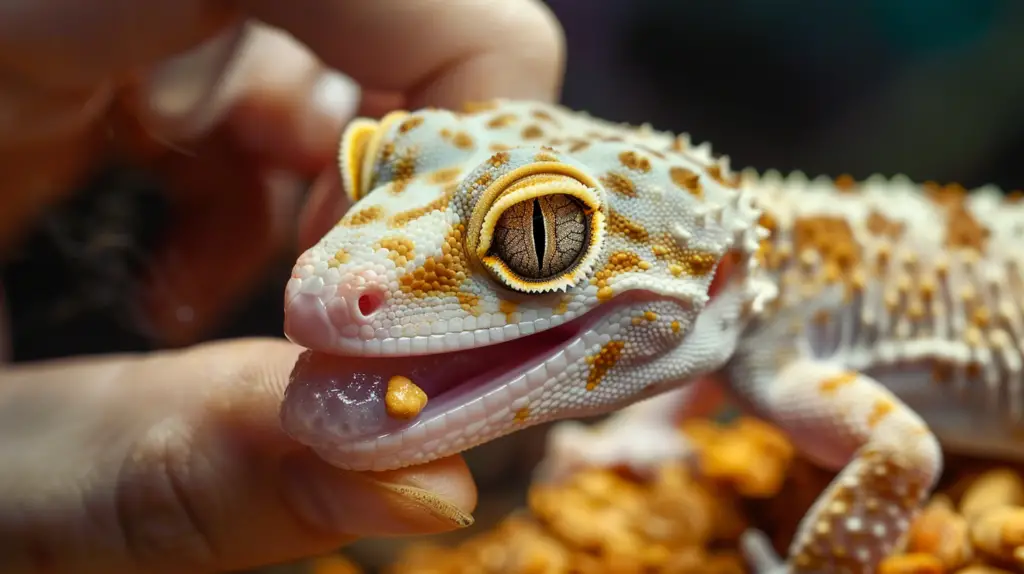
Feeding Crested Geckos
Feeding crested geckos as pets requires understanding their unique dietary needs to ensure they remain healthy and active. This section covers the essential aspects of feeding crested geckos, including their dietary needs, the Crested Gecko Diet (CGD), and incorporating live insects.
Dietary Needs
Crested geckos have specific dietary requirements that must be met to maintain their health. Young and growing geckos can be fed as much as they will eat since they use every calorie for growth. Adult female geckos that are actively breeding have relatively high caloric requirements and need a constant source of calcium for egg production.
Overfeeding can lead to health issues such as fatty liver disease. It is crucial to keep geckos at an ideal weight, where they do not show any ribs or pelvic bones and look robust and healthy. On the other hand, underfeeding is also a common issue, with some recommendations suggesting feeding only 2-3 times per week. However, it is healthier to offer food at least 5 times per week.
Crested Gecko Diet (CGD)
The Crested Gecko Diet (CGD) is a specially formulated diet that provides all the necessary nutrients for crested geckos. It is generally recommended to feed the Pangea Fruit Mix Complete Gecko Diets 3-4 days per week. CGD is a convenient and balanced option that ensures geckos receive a variety of nutrients.
| Feeding Schedule | Recommended Frequency |
|---|---|
| Pangea Fruit Mix Complete Gecko Diets | 3-4 days per week |
| Live Insects | 1-2 days per week |
The table above outlines a recommended feeding schedule for crested geckos, combining CGD and live insects.
Incorporating Live Insects
Incorporating live insects into the diet of crested geckos provides essential benefits. Live insects offer variety, exercise, and mental stimulation. Generally, feeding live insects 1-2 times per week is recommended.
Types of live insects suitable for crested geckos include:
- Crickets
- Dubia Roaches
- Mealworms
- Waxworms (as a treat)
It is important to ensure that the insects are gut-loaded and dusted with appropriate supplements before feeding them to the geckos. This helps to provide additional nutrients that may not be present in the insects’ natural diet.
To further explore the care and feeding of geckos, check out our articles on gecko pet care and types of geckos as pets.
By understanding the dietary needs, incorporating the Crested Gecko Diet, and adding live insects, you can ensure your crested gecko thrives. For more detailed information and tips on keeping your gecko healthy, visit our other related articles.
Monitoring Geckos’ Appetite
Keeping a close eye on your gecko’s eating habits is essential for ensuring their overall health. This section will help you recognize signs of overfeeding and underfeeding, as well as provide guidance on addressing common eating issues.
Signs of Overfeeding
Overfeeding geckos can lead to health complications such as fatty liver disease. To determine if a gecko is overfed, observe their physical condition. A healthy gecko should appear robust without any visible ribs or pelvic bones. If your gecko appears overweight, consider reducing the amount of food offered while maintaining a regular feeding schedule.
| Indicator | Description |
|---|---|
| Visible Ribs/Pelvic Bones | No |
| Body Condition | Robust, healthy |
| Weight | Stable, not excessive |
Signs of Underfeeding
Underfeeding is a common issue, often resulting from misconceptions about feeding frequency. A healthier approach is to offer food at least five times per week, with a minimum of four times. Consider feeding Pangea Fruit Mix Complete Gecko Diets 3-4 days per week and live insects 1-2 days per week for a balanced diet (Pangea Reptile).
| Indicator | Description |
|---|---|
| Feeding Frequency | Less than 4 times/week |
| Body Condition | Thin, possible visible bones |
| Weight | Decreasing |
Addressing Eating Issues
Various factors can affect a gecko’s appetite, including stress, environmental changes, and health issues. Here are some common causes and solutions:
- Environmental Changes: Stress from changes in environment, lighting, or temperature can lead to temporary disinterest in food. Ensure their habitat is stable and suitable for their needs. Learn more about setting up the perfect habitat in our gecko habitat setup.
- Brumation: During brumation, geckos may not eat or defecate but should maintain stable weight. If weight loss exceeds 5-10%, consult a veterinarian as it may not be brumation.
- Bullying: Geckos kept with other geckos may experience bullying, leading to stress and reduced appetite. Use separate feeding bowls, tank partitions, or consider housing geckos separately (JustAnswer).
- Feeding Response: Monitor the gecko’s response to the number of insects provided. If they consistently finish all the food, offer a few more insects next time. If they never finish, reduce the quantity.
For more detailed information on caring for your gecko, visit our comprehensive guide on gecko pet care.
Factors Affecting Geckos’ Appetite
Understanding the factors influencing geckos’ appetite is crucial for their health and well-being. Various environmental, health, and behavioral factors can impact their eating habits.
Environmental Factors
Environmental conditions play a significant role in a gecko’s appetite. Improper lighting and temperature levels can negatively affect their desire to eat. Leopard geckos, as cold-blooded animals, require specific temperature ranges for proper digestion. Ensuring an appropriate gecko habitat setup is essential.
| Environmental Condition | Impact on Appetite |
|---|---|
| Incorrect Temperature | Decreased appetite |
| Improper Lighting | Reduced feeding interest |
| Stressful Environment | Temporary disinterest in food |
| Brumation | Seasonal depression of appetite |
Health Factors
Health problems can also affect a gecko’s eating habits. Overfeeding can lead to obesity and health issues such as fatty liver disease. It’s important to maintain an ideal weight where geckos look robust and healthy without showing ribs or pelvic bones. Conversely, underfeeding can result in malnutrition and weakened immune systems.
| Health Condition | Impact on Appetite |
|---|---|
| Obesity | Decreased interest in food |
| Malnutrition | Increased susceptibility to diseases |
| Brumation | Temporary reduction in appetite |
| Illness | Loss of appetite |
For more information on gecko health, visit our gecko pet care page.
Behavioral Factors
Behavioral elements such as stress, changes in environment, and social dynamics can affect geckos’ appetite. Stress from changes in their surroundings, lighting, or diet can cause temporary disinterest in food. Additionally, geckos kept with other geckos may experience bullying by more dominant individuals, leading to stress or physical intimidation that can prevent a submissive gecko from eating.
| Behavioral Factor | Impact on Appetite |
|---|---|
| Stress | Reduced feeding interest |
| Environmental Changes | Temporary disinterest in food |
| Social Dynamics | Inhibited feeding due to bullying |
To learn more about handling and taming your gecko, check out our gecko handling and taming guide.
By understanding these factors, gecko enthusiasts can ensure their pets maintain a healthy and consistent appetite, contributing to their overall well-being.
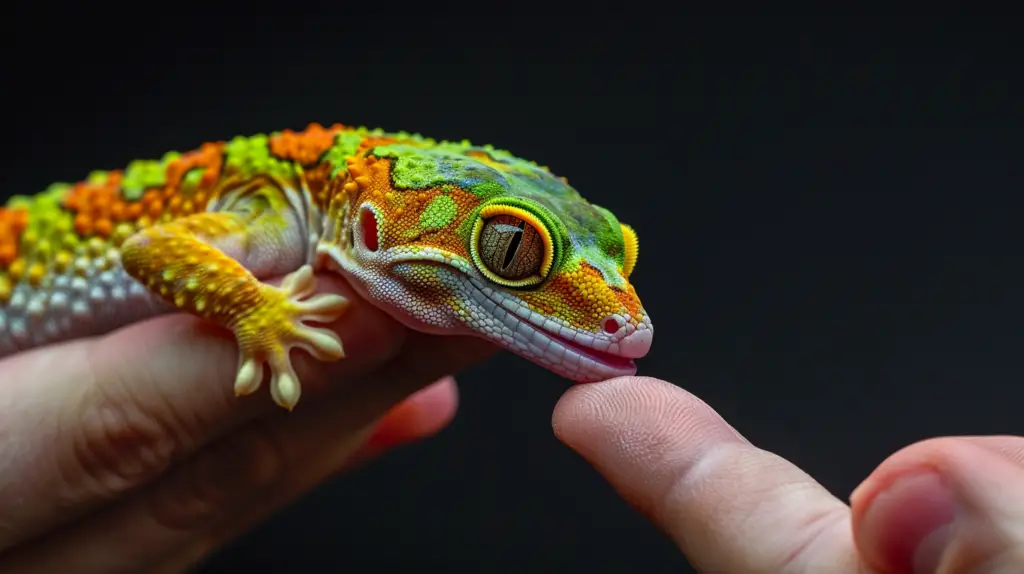
Emergency Feeding Solutions
In some situations, gecko owners may find themselves needing to provide emergency feeding solutions for their pet reptiles. This section covers temporary food alternatives, ensuring nutritional needs, and consulting a veterinarian for expert advice.
Temporary Food Alternatives
When regular food sources are unavailable, temporary alternatives can help ensure your gecko remains nourished. Leopard geckos, for example, typically eat insects such as mealworms and crickets, but certain circumstances may require improvisation.
| Temporary Food Alternatives | Suitable Gecko Types | Feeding Frequency |
|---|---|---|
| Baby Food (chicken or turkey) | Leopard and Crested Geckos | Occasionally |
| Fruits (mango, papaya) | Crested Geckos | Occasionally |
| Boiled Eggs | Leopard Geckos | Sparingly |
| Commercially Prepared Diets | Both | As directed |
These alternatives should only be used temporarily and sparingly to avoid nutritional imbalances. For more information on the best practices in gecko pet care, refer to our detailed guides.
Ensuring Nutritional Needs
While using temporary food alternatives, it is crucial to ensure your gecko’s nutritional needs are met. This includes providing essential vitamins and minerals to maintain their health. Incorporate calcium and vitamin D3 supplements to prevent deficiencies and support bone health (JustAnswer).
| Supplement | Purpose | Frequency |
|---|---|---|
| Calcium Powder | Bone Health | Every Feeding |
| Vitamin D3 | Calcium Absorption | 2-3 Times a Week |
| Multivitamin | General Health | Once a Week |
For an in-depth look at supplementing gecko diets, visit our section on supplementing the diet.
Consulting a Veterinarian
If your gecko’s appetite issues persist or if you observe significant weight loss, it is essential to consult a veterinarian. A professional can diagnose underlying health problems, provide tailored dietary advice, and recommend appropriate treatments.
Indicators that warrant veterinary consultation include:
- Rapid or significant weight loss
- Persistent refusal to eat
- Visible signs of illness or distress
- Unusual behavior changes
Maintaining regular check-ups and being proactive about your gecko’s health can prevent minor issues from becoming serious problems. For more insights on caring for geckos, explore our articles on gecko habitat setup and gecko handling and taming.
